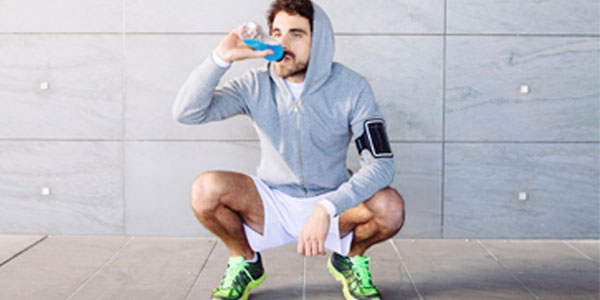Put at risks of Energy Drinks
Trying to boost your performance with an energy drink can actually do more harm
than good.Advertisements for energy drinks are plastered on the walls at sporting events and on the jerseys of leading athletes. The beverage makers sponsor models, music events and videos games. Red Bull, the market’s leading drink, even has its own television series and printed magazine. Makers of such drinks claim their elixirs will boost your immune system, enhance your performance and help you feel energized.
No wonder 30 to 50 percent of adolescents and young adults say they buy energy drinks. According to a study from the U.S. Centers for Disease Control and Prevention, 8 percent of young people drink energy drinks weekly, 20 percent think that energy drinks are safe drinks for teenagers and 13 percent think that energy drinks are a type of sports drink. Marketed for young adults, sales of energy drinks and shots in the United States are expected to climb to $21 billion by 2017 from $12.5 billion in 2012, according to a report by market research company Packaged Facts.
But are they safe to drink — especially for teenagers and young adults?
Stephanie Nguyen Lai, M.D., a pediatrician with the Palo Alto Medical Foundation, says the simple answer is “no.” She says energy drinks are full of sugar, sodium and loaded with caffeine – often twice as much as coffee and eight times as much as a soda. They’re an unhealthy beverage for anyone, especially a growing youth’s body.
“As a parent, it is important to talk with your adolescent and explain the risks of these products,” Dr. Lai says. “Caffeine is a drug and is not recommended for children, particularly at these high quantities. Moreover, these drinks are especially dangerous when mixed with alcohol, which many young people do.”

Hidden Caffeine in Energy Drinks
The caffeine content in popular energy drinks varies greatly as the energy drink industry is not regulated by the United States Food and Drug Administration. Ironically, some drinks do not even list the caffeine content on their label. Instead, they state that it’s part of their secret “proprietary blend.”
Energy drink makers also claim their beverages are “natural dietary supplements,” thus not subject to the regulations that apply to food products. This means consumers often do not know how much caffeine they’re downing with an energy drink, and it’s likely a lot more than you think. A typical 16-ounce energy drink contains between 150 to 280 milligrams of caffeine; larger cans have up to 500 milligrams of caffeine. This is in stark contrast to sodas, which are regulated by the FDA. By comparison, a 12-ounce can of soda can contains about 35 milligrams of caffeine.
Many energy drinks also contain guarana, which is a South American plant with a more potent form of caffeine. One gram of guaranine, a derivative of guarana, is equivalent to 40 to 80 milligrams of caffeine. Due to these additives, these energy drinks can contain much more caffeine than stated on the packaging.
Side Effects of Too Much Caffeine
If you’ve tried to break your caffeine habit, then you know there are many negative side effects to ingesting too much caffeine. Side effects of too much caffeine include:
- Increased heart rate
- High blood pressure
- Heart palpitations
- Insomnia
- Dehydration
- Restlessness
Caffeine withdrawal is associated with headache, marked fatigue, anxiety, tremors and irritability.
Energy drinks also contain other substances touted to improve energy, such as taurine, ginseng, vitamin B, carnitine and bitter orange. But Dr. Lai says these ingredients haven’t been vetted properly.
“Unfortunately, the safety and effects of daily consumption of these additives are not well known,” she says.
Mixing Energy Drinks and Alcohol
Dr. Lai says she is most concerned with products that mix energy drinks with alcohol. Many of these have packaging that is similar to non-alcoholic energy drinks. Although you must be over 21 to buy the drinks, teenagers can often get them through friends or with fake IDs. It’s also becoming more common for teenagers to create their own cocktails by mixing energy drinks with hard liquor.
“Combining high-caffeine energy drinks with alcohol may give teenagers the perception that they aren’t as drunk as they really are. And when teens feel fewer effects from alcohol, they tend to drink more,” Dr. Lai says. “This problem became apparent in 2010, when several young adults were hospitalized at Washington State due to overconsumption of alcoholic energy drinks.”
Mixing the two liquids together increases the likelihood of engaging in risky behavior, especially drunk driving and binge drinking. A research paper published in 2015 in the Advances in Nutrition journal found that people who combined energy drinks and alcohol were four times more likely to think they could drive home safely than their counterparts who drank alcohol alone. In addition, a 2014 Journal of Pediatrics study found that mixing the two beverages was associated with binge drinking among teenagers.
A similar study in 2015 by the University of Toronto found that alcoholic energy drinks are related to adolescent brain damage. Researchers discovered that teenagers who reported sustaining a brain injury within the past year were at least twice as likely to have consumed energy drinks mixed with alcohol than teens who reported sustaining a traumatic brain injury more than a year previously.
The Bottom Line
The American Academy of Pediatrics and the American Academy of Family Physicians have taken the stance that caffeine and other stimulant substances contained in energy drinks have no place in the diet of children and adolescents.
The same health cautions are applicable for adults. If you’re an adult still looking for a caffeine boost, be cautious when imbibing energy drinks. If you’re trying to wean off caffeine completely, try gradually reducing your caffeine intake on a weekly basis. Try drinking half-decaf coffee, then decaf coffee before switching to another non-caffeinated beverage such as herbal tea.




Comments
Post a Comment